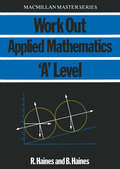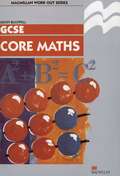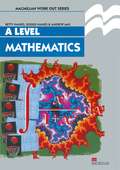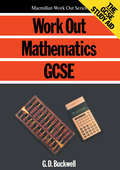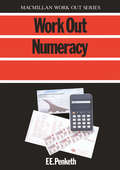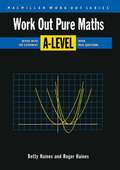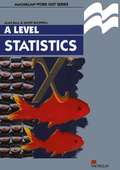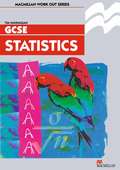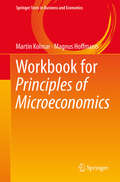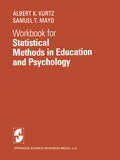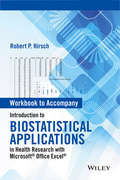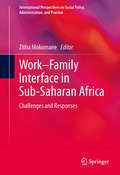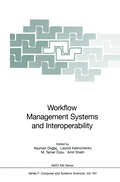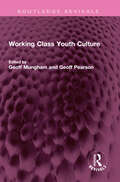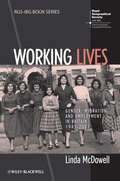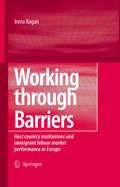- Table View
- List View
Work Out Core Mathematics GCSE/KS4 (Macmillan Work Out)
by Geoff BuckwellWork Out Core Mathematics covers all the central ability band - Intermediate or Core - of the syllabuses set by the major examining groups. It is a practical and comprehensive aid to a thorough understanding of the mathematics taught at this level. The book includes concise notes, fully worked examples and over 120 actual and specimen examination questions with answers. Each section includes check-tests so that the reader can make a realistic assessment of progress and understanding in each topic.
Work Out Mathematics A Level (Work Out)
by Betty HainesSuitable for use with all Boards' syllabuses, with masses of recent questions, worked in full, or in part with solution hints. Work Out Mathematics A Level is based on a careful review of the areas that students find difficult. Special features include: * new structure for the new A level core, including Statistics * fact sheet of key definitions, formulae and relations to kick off every chapter * full integration of the power of the graphical calculator into A level work * recognises the extra help needed by the post-GCSE student. From reviews of the previous editions: 'Laid out well and easy to follow.' - Paul Belcher, Mathematical Gazette 'Solutions are well written and provide a good model for examinees. ...A useful revision and exam preparation aid...recommended.' - John Taylor, Mathematical Spectrum.
Work Out Pure Mathematics A-Level (Macmillan Work Out)
by R. HainesA text for students preparing for their A-level examinations in mathematics.
Work Out Statistics A-Level (Macmillan Work Out)
by Alan Ball Geoff BuckwellEverything you need for success in Statistics at A-Level: * Advice on the course, study and exam technique * Knowledge - fact sheets of essential formulas and key definitions * Fully worked examples of real exam questions, with hints and tips on how best to solve them * Practice - full of recent questions with answers * Confidence - outline solutions to exercises, so you can check and assess your understanding topic by topic
Work Out Statistics GCSE (Macmillan Work Out)
by Tim Hannagan`The book has a very distinctive structure in which each chapter begins with an outline of the techniques, followed by worked examples plus a large number of recent examination questions...' Tim Hannagan includes a wide spread of statistical methods, techniques and concepts. He offers success in understanding statistics for a broad range of students, including those of limited mathematical knowledge or confidence. A section on basic mathematics reminds students of the simple numerical techniques they will need. `...presentation is clear, concise and informative. Initial sections provide a valuable revision or summary... The worked examples are essential reading... ...because they are a useful indication of how to tackle examination questions and more because they contain essential teaching material.' (all quotes from Mike Skudder, Quarterly Review of Marketing)
Workbook for Principles of Microeconomics (Springer Texts in Business and Economics)
by Martin Kolmar Magnus HoffmannThis is the companion workbook for the textbook Principles of Microeconomics. Each chapter features a wide variety of exercises, ranging from basic multiple-choice questions to challenging mathematical problems and case study scenarios. The textbook pursues an integrative approach to modern microeconomics by critically reflecting on the main findings of economics from a philosophical standpoint and comparing them to approaches found in the social sciences. It adopts an institutional perspective to analyze the potential and limitations of different market types, and highlights implications for the design of the legal system and business practices throughout. In addition to traditional rational-choice models, important findings from behavioral economics and psychology are also presented.
Workbook to Accompany Introduction to Biostatistical Applications in Health Research with Microsoft Office Excel
by Robert P. HirschWorkbook to accompany Introduction to Biostatistical Applications in Health Research with Microsoft Office Excel—practical and methodological approach to the statistical logic of biostatistics in the field of health research.
Workbook to Accompany Introduction to Biostatistical Applications in Health Research with Microsoft Office Excel
by Robert P. HirschWorkbook to accompany Introduction to Biostatistical Applications in Health Research with Microsoft Office Excel—practical and methodological approach to the statistical logic of biostatistics in the field of health research.
A Worked Problem Approach: Introductory Finance 361. A custom for University of Nebraska - Lincoln
by John GeppertThis book is intended to be your first introduction to the TOOLS of finance. It is not a survey of finance, but rather a collection of the foundational tools you can ACTUALLY USE to solve finance problems you will encounter in your personal life and careers. It is intended to be used in the first finance course for finance majors and as a finance founda-tion course for all business majors. The resources contained within are designed to teach you the material and provide you with a reference you can refer back to as you progress to higher level finance courses, or as a targeted refresher.
Work–Family Interface in Sub-Saharan Africa: Challenges and Responses (International Perspectives on Social Policy, Administration, and Practice)
by Zitha MokomaneProblems associated with work-family conflict do not belong to individual families alone, but have a major social and economic impact on the greater community. This scenario also holds true across sub-Saharan Africa, as nations enter the global economy and rising numbers of women enter the workforce.One of the first resources to focus on this region, Work-Family Interface in Sub-Saharan Africa probes rarely-studied dimensions of conflict between paid employment and family responsibilities. It balances theoretical background, empirical findings and current and emerging interventions for an insightful and practical review of ongoing issues affecting working women with families. Coverage contrasts concepts of work and family between the developing world and the West and related social concerns such as gender expectations and sexual harassment are examined in the work context. The book describes a range of family strategies for resolving work-family friction and chapters end with policy recommendations as first steps toward remedying longstanding challenges. Among the thought-provoking dispatches:Ghana: Managing work and family demandsNigeria: Strain-based family interference with workBotswana: The social impact of job transfer policy on dual-career familiesKenya: The role of household help in work-family balanceSouth Africa: State measures toward work-care integrationZambia: The quest for a family policyAs evinced by these chapters, progress is gradual and far from uniform. As a guide for future study and future policy, Work-Family Interface in Sub-Saharan Africa is a substantial reference for sociologists, public health professionals, public and social policymakers and administrators.
Workflow Management Systems and Interoperability (NATO ASI Subseries F: #164)
by Asuman Dogac Leonid Kalinichenko Tamer Özsu Amit ShethWorkflow management systems (WFMS) are enjoying increasing popular ity due to their ability to coordinate and streamline complex organizational processes within organizations of all sizes. Organizational processes are de scriptions of an organization's activities engineered to fulfill its mission such as completing a business contract or satisfying a specific customer request. Gaining control of these processes allows an organization to reengineer and improve each process or adapt them to changing requirements. The goal of WFMSs is to manage these organizational processes and coordinate their execution. was demonstrated in the first half The high degree of interest in WFMSs of the 1990s by a significant increase in the number of commercial products (once estimated to about 250) and the estimated market size (in combined $2 billion in 1996. Ensuing maturity product sales and services) of about is demonstrated by consolidations during the last year. Ranging from mere e-mail based calendar tools and flow charting tools to very sophisticated inte grated development environments for distributed enterprise-wide applications and systems to support programming in the large, these products are finding an eager market and opening up important research and development op portunities. In spite of their early success in the market place, however, the current generation of systems can benefit from further research and develop ment, especially for increasingly complex and mission-critical applications.
Working Beyond 60: Key Policies and Practices in Europe
by G. Reday-MulveyWhile the question to why work beyond sixty has now become obvious, the how and for whom questions are the real topic of this new study by one of the best European specialists in the area. Work after sixty - if it is to be feasible and widespread - has to be on a part-time basis to meet the wishes and needs of workers and companies. This book provides an in-depth analysis of the growing importance of work beyond sixty and a comparative discussion of new policies in several EU Member States as well as of company practice.
Working Class Youth Culture (Routledge Revivals)
by Geoff Mungham Geoff PearsonFirst published in 1976, Working Class Youth Culture offers a much-needed alternative viewpoint to the law-and-order lobby which treats the youth question as a dreadful pest to be exterminated or caged in. The contributors describe the real conditions of life for working-class youth; how they make sense of the world; and how we can understand their perspective. The subjects discussed include Teddy Boys, Mods, Skinheads and the Glamrock Cult; dance-hall fights; picking up girls and going steady; how schools manufacture delinquency, truancy and vandalism; how working-class kids slide from bad schools to bad jobs, or to no jobs at all; Paki-bashing, racism and the competition over jobs and houses; how social change in post-war Britain has influenced youth culture; and how social scientists have hidden the real character of youth troubles behind the myth of a classless society. This book will be of interest to students of sociology and anthropology.
Working Class Youth Culture (Routledge Revivals)
First published in 1976, Working Class Youth Culture offers a much-needed alternative viewpoint to the law-and-order lobby which treats the youth question as a dreadful pest to be exterminated or caged in. The contributors describe the real conditions of life for working-class youth; how they make sense of the world; and how we can understand their perspective. The subjects discussed include Teddy Boys, Mods, Skinheads and the Glamrock Cult; dance-hall fights; picking up girls and going steady; how schools manufacture delinquency, truancy and vandalism; how working-class kids slide from bad schools to bad jobs, or to no jobs at all; Paki-bashing, racism and the competition over jobs and houses; how social change in post-war Britain has influenced youth culture; and how social scientists have hidden the real character of youth troubles behind the myth of a classless society. This book will be of interest to students of sociology and anthropology.
Working for Yourself Without Capital
by B.H. ElvyMost of the schemes to assist the unemployed to set-up in business for themselves require applicants to contribute towards the start-up capital. Yet many people thrown out of work by the recession are not in a position to do so. This book explores a number of business options that can be started with minimal outlay. It also explains how to control the money side, find customers and organise oneself to earn money by using one's personal skills, knowledge and experience.
Working Lives: Gender, Migration and Employment in Britain, 1945-2007 (RGS-IBG Book Series)
by Linda McDowellFull of unique and compelling insights into the working lives of migrant women in the UK, this book draws on more than two decades of in-depth research to explore the changing nature of women’s employment in post-war Britain. A first-rate example of theoretically located empirical analysis of labour market change in contemporary Britain Includes compelling case studies that combine historical documentation of social change with fascinating first-hand accounts of women’s working lives over decades Integrates information gleaned from more than two decades of in-depth research Revealing comparative analysis of the similarities and differences in the lives of immigrant working women in post-war Britain Features real-life accounts of women’s under-reported experiences of migration
Working Lives: Gender, Migration and Employment in Britain, 1945-2007 (RGS-IBG Book Series)
by Linda McDowellFull of unique and compelling insights into the working lives of migrant women in the UK, this book draws on more than two decades of in-depth research to explore the changing nature of women’s employment in post-war Britain. A first-rate example of theoretically located empirical analysis of labour market change in contemporary Britain Includes compelling case studies that combine historical documentation of social change with fascinating first-hand accounts of women’s working lives over decades Integrates information gleaned from more than two decades of in-depth research Revealing comparative analysis of the similarities and differences in the lives of immigrant working women in post-war Britain Features real-life accounts of women’s under-reported experiences of migration
Working Through Barriers: Host Country Institutions and Immigrant Labour Market Performance in Europe
by Irena KoganThis book examines the role that institutional characteristics of host countries play in labour market integration of immigrants in the European Union. Drawing on existing research, it develops a comprehensive conceptual framework of factors and underlying mechanisms which affect immigrant integration in the fifteen nations that comprise the European Union. The author analyzes selected EU countries in depth, investigating the extent to which immigrants have succeeded or failed in different institutional contexts.
Working Toward Solutions in Fluid Dynamics and Astrophysics: What the Equations Don’t Say (SpringerBriefs in History of Science and Technology)
by Lydia Patton Erik CurielThis book focuses on continuing the long-standing productive dialogue between physical science and the philosophy of science. Researchers and readers who want to keep up to date on front-line scientific research in fluid mechanics and gravitational wave astrophysics will find timely and well-informed analyses of this scientific research and its philosophical significance. These exciting frontiers of research pose deep scientific problems, and raise key questions in the philosophy of science related to scientific explanation and understanding, theory change and assessment, measurement, interpretation, realism, and modeling. The audience of the book includes philosophers of science, philosophers of mathematics, scientists with philosophical interests, and students in philosophy, history, mathematics, and science. Anyone who is interested in the methods and philosophical questions behind the recent exciting work in physics discussed here will profit from reading this book.
Working With Diagrams (Studies in Social Analysis #14)
by Lukas Engelmann, Caroline Humphrey Christos LynterisArising from the need to go beyond the semiotic, cognitive, epistemic and symbolic reading of diagrams, this book looks at what diagrams are capable of in scholarly work related to the social sciences. Rather than attempting to define what diagrams are, and what their dietic capacity might be, contributions to this volume draw together the work diagrams do in the development of theories. Across a range of disciplines, the chapters introduce the ephemeral dimensions of scientist’s interactions and collaboration with diagrams, consider how diagrams configure cooperation across disciplines, and explore how diagrams have been made to work in ways that point beyond simplification, clarification and formalization.
